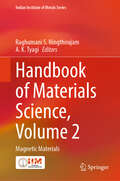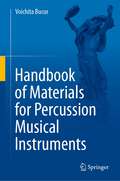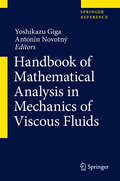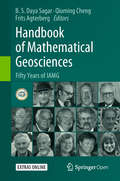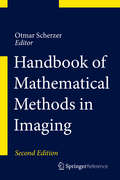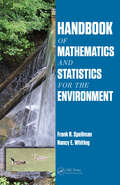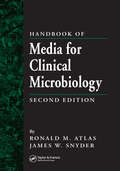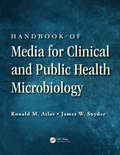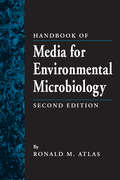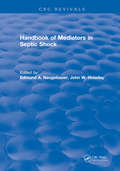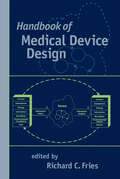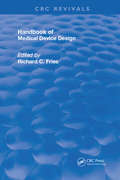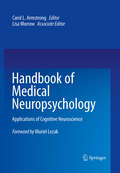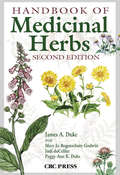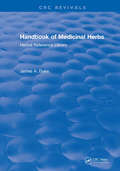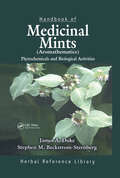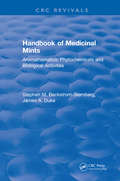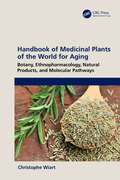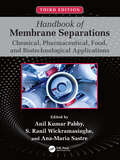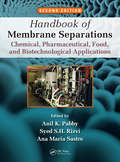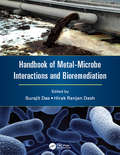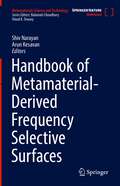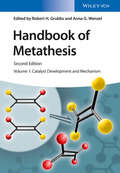- Table View
- List View
Handbook of Materials Science, Volume 2: Magnetic Materials (Indian Institute of Metals Series)
by A. K. Tyagi Raghumani S. NingthoujamThis book presents state-of-the-art coverage of the basic concepts of magnetization. The book focuses on electron-spin interaction, electron-spin-magnetic field interactions with or without angular dependent, magnetic properties with the dimension of particles or surrounding environment, proximity effects on core-shell structure or hybrid or composite and their applications. It also discusses recent advances in magnetic materials and its future scope. This book is of interest to students, researchers and professionals working in the area of materials science, especially magnetic materials and allied fields.
Handbook of Materials Selection for Engineering Applications
by G. T. MurrayReflecting the rapid advances in new materials development, this work offers up-to-date information on the properties and applications of various classes of metals, polymers, ceramics and composites. It aims to simplify the materials selection process and show how to lower materials and manufacturing costs, drawing on such sources as vendor supplie
Handbook of Materials for Percussion Musical Instruments
by Voichita BucurThis book describes the properties of materials used for making percussion instruments for classical music played by a symphony orchestra in which the instruments could be played as a soloist instrument or as a group or several groups of instruments, as they are included into a musical work. A chapter is devoted to the bells. The scope of this book is primarily confined to percussion instruments of symphony orchestras taking into account the centuries of musical art and tradition. This book bridges the gap in the technical literature on describing the properties of materials for percussion instruments—timpani, other drums, marimba, xylophone, vibraphone, gong, cymbal, triangle, celesta, castanets.
Handbook of Mathematical Analysis in Mechanics of Viscous Fluids
by Yoshikazu Giga Antonín NovotnýMathematics has always played a key role for researches in fluid mechanics. The purpose of this handbook is to give an overview of items that are key to handling problems in fluid mechanics. Since the field of fluid mechanics is huge, it is almost impossible to cover many topics. In this handbook, we focus on mathematical analysis on viscous Newtonian fluid. The first part is devoted to mathematical analysis on incompressible fluids while part 2 is devoted to compressible fluids.
Handbook of Mathematical Geosciences: Fifty Years of IAMG
by Frits Agterberg B.S. Daya Sagar Qiuming ChengThis Open Access handbook published at the IAMG's 50th anniversary, presents a compilation of invited path-breaking research contributions by award-winning geoscientists who have been instrumental in shaping the IAMG. It contains 45 chapters that are categorized broadly into five parts (i) theory, (ii) general applications, (iii) exploration and resource estimation, (iv) reviews, and (v) reminiscences covering related topics like mathematical geosciences, mathematical morphology, geostatistics, fractals and multifractals, spatial statistics, multipoint geostatistics, compositional data analysis, informatics, geocomputation, numerical methods, and chaos theory in the geosciences.
Handbook of Mathematical Methods in Imaging
by Otmar ScherzerThe Handbook of Mathematical Methods in Imaging provides a comprehensive treatment of the mathematical techniques used in imaging science. The material is grouped into two central themes, namely, Inverse Problems (Algorithmic Reconstruction) and Signal and Image Processing. Each section within the themes covers applications (modeling), mathematics, numerical methods (using a case example) and open questions. Written by experts in the area, the presentation is mathematically rigorous. The entries are cross-referenced for easy navigation through connected topics. Available in both print and electronic forms, the handbook is enhanced by more than 150 illustrations and an extended bibliography. It will benefit students, scientists and researchers in applied mathematics. Engineers and computer scientists working in imaging will also find this handbook useful.
Handbook of Mathematics and Statistics for the Environment
by Frank R. Spellman Nancy E. WhitingA thorough revision of the previous "Environmental Engineer's Mathematics Handbook," this book offers readers an unusual approach to presenting environmental math concepts, emphasizing the relationship between the principles in natural processes and environmental processes. It integrates the fundamental math operations performed by environmental pr
Handbook of Media for Clinical Microbiology
by Ronald M. Atlas James W. SnyderWhile evolving molecular diagnostic methods are being heralded for the role they will play in improving our ability to cultivate and identify bacteria, fungi, and viruses, the reality is that those new methods are still beyond the technical and financial reach of most clinical laboratories. Most clinical microbiology laboratories still rely upon cu
Handbook of Media for Clinical and Public Health Microbiology
by Ronald M. Atlas James W. SnyderThe detection and/or isolation and identification of pathogenic microorganisms is critical for the laboratory diagnosis of infectious diseases. With growth-dependant methods providing reliable means for identifying pathogens, traditional culturing continues to play an integral role in the detection and characterization of known and "new" microbial
Handbook of Media for Environmental Microbiology
by Ronald M. AtlasThe second edition of a bestseller, this book provides a comprehensive reference for the cultivation of bacteria, Archaea, and fungi from diverse environments, including extreme habitats. Expanded to include 2,000 media formulations, this book compiles the descriptions of media of relevance for the cultivation of microorganisms from soil, water, an
Handbook of Mediators in Septic Shock
by Edmund A. NeugebauerHandbook of Mediators in Septic Shock presents a comprehensive, systematic evaluation of the various putative mediators of septic shock through the use of meta-analysis. Experts of individual mediators have objectively evaluated the collective literature using classical Koch-Dale Criteria for causal relationships. A decision tree approach has been used to analyze the existing evidence for each of the four Koch-Dale Criteria for each individual mediator of septic shock. The book provides an integrated perspective that describes how these many mediators interact. It also covers how advances in mathematical modeling of complex realities are applied to the field of septic shock pathogenesis. CRC Handbook of Mediators in Septic Shock will be a useful reference for emergency room and intensive care physicians, trauma specialists, pathophysiologists, physiologists, biochemists, pharmacologists, and others interested in the topic. Features
Handbook of Medical Device Design
by Richard C. FriesThe Handbook of Medical Device Design provides a review of regulatory and standards issues in medical device design, including FDA regulations, types of 510 (k), the ISO 9000 series, and medical device directives. It identifies how to determine and document customer needs and device requirements. It also establishes reliability and qua
Handbook of Medical Device Design (Routledge Revivals)
by Richard C. FriesFirst published in 2001: This handbook has been written to give those professionals working in the development and use of medical devices practical knowledge about biomedical technology, regulations, and their relationship to quality health care.
Handbook of Medical Neuropsychology
by Carol L. Armstrong Lisa MorrowThe recent surge of interest in the neuroscience of autism, HIV/AIDS, cancer, Alzheimer's, and other disorders has brought with it an increasing awareness of the effects of medical conditions on the brain and behavior--an awareness extending through the research and practice arenas, among those working with pediatric and adult clients alike. Comprehensive in scope and highly detailed in its coverage, the Handbook of Medical Neuropsychology is organized to give readers knowledge of the field, whether one needs to understand a clinical evaluation, design a research study, or gain a deeper understanding of disease processes and corresponding behaviors. Featuring the most up-to-date information on cognitive neuroscience to enhance the work of the practitioner, the student, or the researcher, the book handles theory, historical background, practical considerations, and controversial areas with clear explanations, clinical expertise, and real-world insight, and critiques diagnostic and assessment tools specific to disorders. The wide selection of commonly seen and rarely encountered diagnoses covered includes: Primary nervous system disease and injury. Vascular system disease. Developmental, genetic, and structural disorders. Dementia and normal aging. Immune-related disorders. Endocrine disease. Metabolic conditions. Plus a chapter on current and emerging approaches to rehabilitation. Opening out a specialty as it grows in importance, the Handbook of Medical Neuropsychology is an essential resource for the neuropsychology clinician, researcher, or graduate student.
Handbook of Medicinal Herbs
by James A. DukeStill considered the definitive work on medicinal herbs and their uses after two decades, the Handbook of Medicinal Herbs has undergone a long-anticipated revision. In the second edition, world-renowned ethnobotanist James A. Duke provides up-to-date data on over 800 of the world's most important medicinal plant species. The book contains mo
Handbook of Medicinal Herbs: Herbal Reference Library
by James A. DukeA Practical, Authoritative CompendiumThis handbook catalogs 365 species of herbs having medicinal or folk medicinal uses, presenting whatever useful information has been documented on their toxicity and utility in humans and animals. Plants from all over the world - from common cultivars to rare species - are included in these 700 pages. The toxicity of these species varies, but the safety of each has been formally or informally questioned by the Food and Drug Administration, National Cancer Institute, Department of Agriculture, Drug Enforcement Administra-tion, or Herb Trade Association.Easy-to-Locate Facts and FiguresDesigned to enable fast access to important information, this hand-book presents information in both catalog and tabular forms. In the catalog section, plants are presented alphabetically by scientific name. (The index permits you to locate an herb by its common name.) A detailed sketch of the chief identifying features accompa-nies most catalog entries. For each species the following information, as available, is presented and referenced:Family and colloquial namesChemical contentUses and applications - present and historicalProcessing, distribution, and economic potentialToxicological agents and degree of toxicityPoison symptoms in humans and animalsTreatment and antidotes References to original literatureFive Tables of Accessible DataGiven a plant species, you can easily determine its toxins; or, given a toxin, you can discover which plants contain it. These and other data are presented in convenient tabular formats as appendixes to the handbook. Other information contained in these tables include toxicity ranking and other toxicity data (as applicable), such as mode of contact, organs affected, and lethal dose; and proximate analyses of selected foods. These tables are titled:Medicinal Herbs: Toxicity Rank
Handbook of Medicinal Mints ( Aromathematics): Phytochemicals and Biological Activities, Herbal Reference Library
by James A. Duke Stephen M Beckstrom-SternbergThis handbook provides the most complete collection of chemical data available on aromatic mints (Lamiaceae). The authors thoroughly introduce the field of aromathematics. Handbook of Medicinal Mints (Aromatics): Phytochemicals and Biological Activities contains a wealth of quantitative data, including more than 500 references on 10,839 chemicals from 251 assays of 205 unique taxa, combined with 3,324 biological activities and 256 recommended daily allowances and lethal doses. An exhaustive guide, the handbook is the ultimate resource for assessing the potential medicinal value of a particular species.
Handbook of Medicinal Mints: Aromathematics: Phytochemicals and Biological Activities
by Stephen M Beckstrom-SternbergInterest in herbal medicines, aromatherapy, and other traditional applications of aromatic plants has increased tremendously over the last few years. However, very little "hard data" on the properties and uses of these plants has been available until now. This handbook provides the most complete collection of chemical data available on aromatic mints (Lamiaceae). The authors introduce the new field of study, aromathematics, which involves aromatic compounds and their biological activities. This book contains a wealth of quantitative data, including more than 500 references on 10,839 chemicals from 251 assays of 205 unique taxa, combined with 3,324 biological activities and 256 recommended daily allowances and lethal doses. An exhaustive guide, the handbook is the ultimate resource for assessing the potential medicinal value of a particular species.
Handbook of Medicinal Plants of the World for Aging: Botany, Ethnopharmacology, Natural Products, and Molecular Pathways
by Christophe WiartHandbook of Medicinal Plants of the World for Aging: Botany, Ethnopharmacology, Natural Products, and Molecular Pathways provides an unprecedented comprehensive overview of more than 100 plants used globally as medicine with the potential to prevent premature aging. This handbook covers the pathophysiology of aging from the molecular and cellular to the organ levels, as well as the current state of knowledge about the modes of action of natural products from plants on the pathophysiological pathways related to the (i) cardiovascular system and metabolism, (ii) central nervous system, (iii) kidneys, (iv) bones, (v) skin and hair, and (vi) immune system. Medicinal plants are presented alphabetically. For each plant is indicated the botanical family, synonyms, and common names in English, French, German, Portuguese, Russian, and Spanish. For each plant, the reader will also find the part used, active principles, medical history, contemporary medicinal uses, as well as pharmacological, clinical, and toxicological studies. The bibliographical references have been carefully selected for their relevance. This handbook is intended for medical doctors, nurses, pharmacists, dieticians, and nutritionists, as well as readers with interest in health food and herbs. FEATURES• Alphabetical presentation of over 100 medicinal plants and the pharmacological rationales for their uses for aging• Discusses the medical history, current medicinal uses, and potential candidates for the prevention of premature aging• Introduces the molecular mechanism of natural products on the pathophysiology of aging• Contains a selection of bibliographic references• A useful research tool for postgraduates, academics, and the pharmaceutical, herbal, or nutrition industries Handbook of Medicinal Plants of the World for Aging: Botany, Ethnopharmacology, Natural Products, and Molecular Pathways presents comment sections that invite further research and reflection on the fascinating and timely subject of herbals for healthy aging. This is an ideal reference text for medicinal plant enthusiasts.
Handbook of Membrane Separations: Chemical, Pharmaceutical, Food, and Biotechnological Applications
by Anil Kumar Pabby S. Ranil Wickramasinghe Ana-Maria SastreThe third edition of the Handbook of Membrane Separations: Chemical, Pharmaceutical, Food, and Biotechnological Applications provides a comprehensive discussion of membrane applications. Fully updated to include the latest advancements in membrane science and technology, it is a one-of-its-kind overview of the existing literature. This fully illustrated handbook is written by experts and professionals in membrane applications from around the world. Key Features: • Includes entirely new chapters on organic solvent-resistant nanofiltration, membrane condensers, membrane-reactors in hydrogen production, membrane materials for haemodialysis, and integrated membrane distillation • Covers the full spectrum of membrane technology and its advancements • Explores membrane applications in a range of fields, from biotechnological and food processing to industrial waste management and environmental engineering This book will appeal to both newcomers to membrane science as well as engineers and scientists looking to expand their knowledge on upcoming advancements in the field.
Handbook of Membrane Separations: Chemical, Pharmaceutical, Food, and Biotechnological Applications, Second Edition
by Anil K. Pabby Syed S.H. Rizvi Ana Maria SastreThe Handbook of Membrane Separations: Chemical, Pharmaceutical, Food, and Biotechnological Applications, Second Edition provides detailed information on membrane separation technologies from an international team of experts. The handbook fills an important gap in the current literature by providing a comprehensive discussion of membrane application
Handbook of Metal-Microbe Interactions and Bioremediation
by Surajit Das Hirak Ranjan DashAround the World, metal pollution is a major problem. Conventional practices of toxic metal removal can be ineffective and/or expensive, delaying and exacerbating the crisis. Those communities dealing with contamination must be aware of the fundamentals advances of microbe-mediated metal removal practices because these methods can be easily used and require less remedial intervention. This book describes innovations and efficient applications for metal bioremediation for environments polluted by metal contaminates.
Handbook of Metallonutraceuticals (Nutraceuticals)
by Yashwant Vishnupant Pathak Jayant Nemchand LokhandeThe nutritional and medicinal value of metals, such as zinc, calcium, and iron, has been known in traditional medicine for a long time. Other metals, such as silver and gold, may also have therapeutic and health benefits. Ancient medicines have long incorporated their use in the treatment of diseases, and they have also more recently been explored
Handbook of Metamaterial-Derived Frequency Selective Surfaces (Metamaterials Science and Technology #3)
by Shiv Narayan Arun KesavanThis volume provides a consolidated reference for the applications of frequency selective surfaces (FSS) technology in different sectors such as wireless communications, smart buildings, microwave and medical industries. It covers all aspects of metamaterial FSS technology starting from theoretical simulation, fabrication and measurement all the way to actual hardware implementation. Also included are in-depth discussions on the design methodologies of metamaterial FSS structures and their practical implementation in devices and components. It will be of interest to researchers and engineers working on developing metamaterial-FSS technology.
Handbook of Metathesis
by Robert H. Grubbs Anna G. WenzelThis is the second edition of the Handbook of Metathesis, edited by Nobel Prize Winner Robert H. Grubbs and his team, available as a 3 Volume set as well as as individual volumes: Volume 1: Catalyst DevelopmentVolume 2: Applications in Organic Synthesis Volume 3: Polymer Synthesis. Volume 1, edited by R. H. Grubbs together with A. G. Wenzel focusses on Catalyst Development and Mechanism. The new edition is completely updated (more than 80% new content) and expanded, with a special focus on industrial applications. Written by the "Who-is-Who" of metathesis, this book gives a comprehensive and high-quality overview. It is the perfect and ultimate one-stop-reference source in this field and indispensable for chemists in academia and industry alike.
